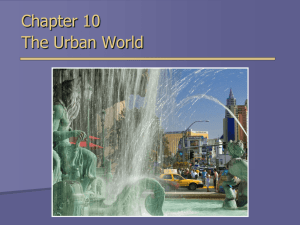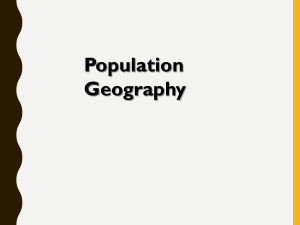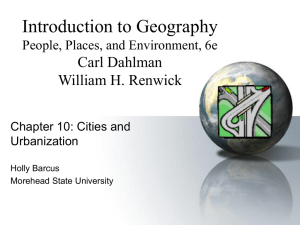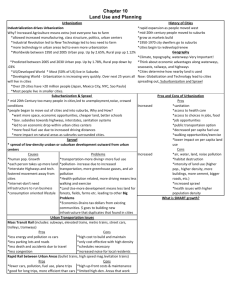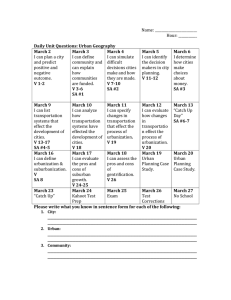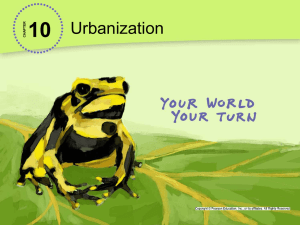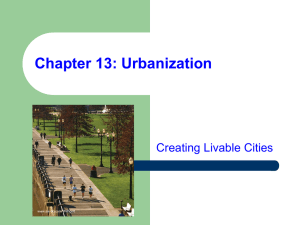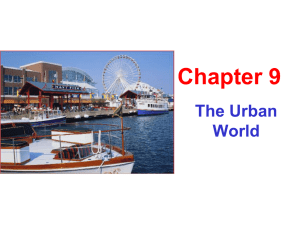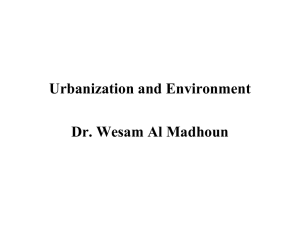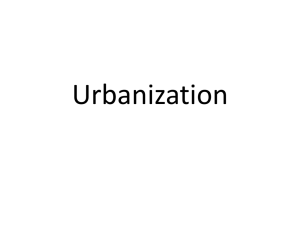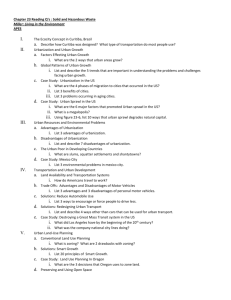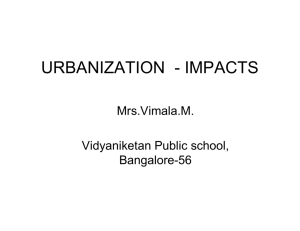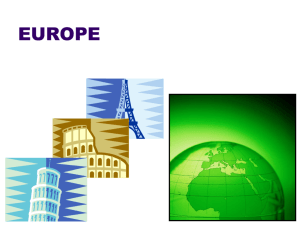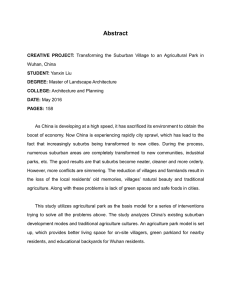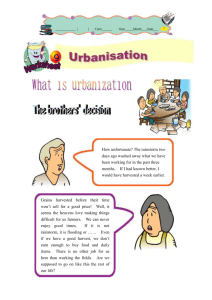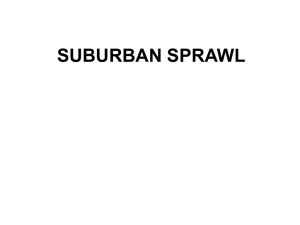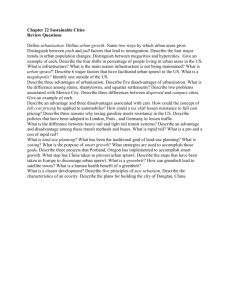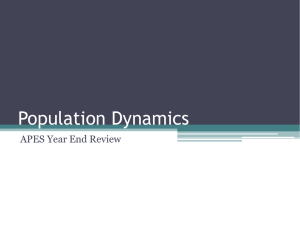The Urban Environment
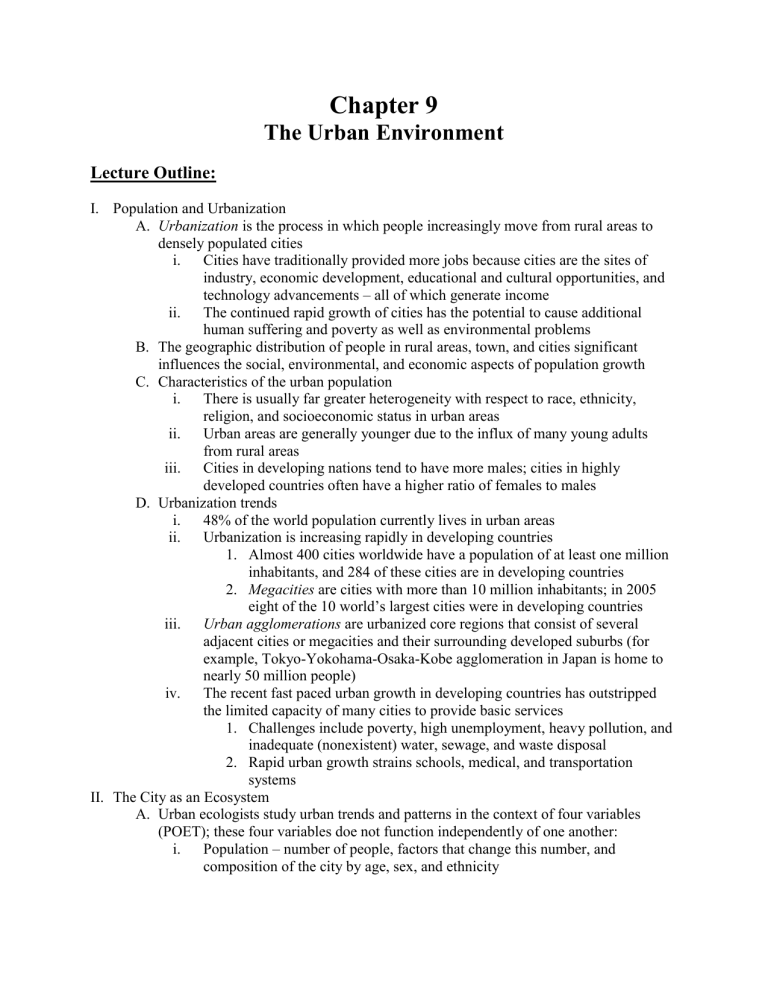
Chapter 9
The Urban Environment
Lecture Outline:
I.
Population and Urbanization
A.
Urbanization is the process in which people increasingly move from rural areas to densely populated cities i.
Cities have traditionally provided more jobs because cities are the sites of industry, economic development, educational and cultural opportunities, and technology advancements – all of which generate income ii.
The continued rapid growth of cities has the potential to cause additional human suffering and poverty as well as environmental problems
B.
The geographic distribution of people in rural areas, town, and cities significant influences the social, environmental, and economic aspects of population growth
C.
Characteristics of the urban population i.
There is usually far greater heterogeneity with respect to race, ethnicity, religion, and socioeconomic status in urban areas ii.
Urban areas are generally younger due to the influx of many young adults from rural areas iii.
Cities in developing nations tend to have more males; cities in highly developed countries often have a higher ratio of females to males
D.
Urbanization trends i.
48% of the world population currently lives in urban areas ii.
Urbanization is increasing rapidly in developing countries
1.
Almost 400 cities worldwide have a population of at least one million inhabitants, and 284 of these cities are in developing countries
2.
Megacities are cities with more than 10 million inhabitants; in 2005 eight of the 10 world’s largest cities were in developing countries iii.
Urban agglomerations are urbanized core regions that consist of several adjacent cities or megacities and their surrounding developed suburbs (for example, Tokyo-Yokohama-Osaka-Kobe agglomeration in Japan is home to nearly 50 million people) iv.
The recent fast paced urban growth in developing countries has outstripped the limited capacity of many cities to provide basic services
1.
Challenges include poverty, high unemployment, heavy pollution, and inadequate (nonexistent) water, sewage, and waste disposal
2.
Rapid urban growth strains schools, medical, and transportation systems
II.
The City as an Ecosystem
A.
Urban ecologists study urban trends and patterns in the context of four variables
(POET); these four variables doe not function independently of one another: i.
Population – number of people, factors that change this number, and composition of the city by age, sex, and ethnicity
ii.
Organization – social structure of the city, including its economic policies, method of government, and social hierarchy iii.
Environment – considers both the natural environment and the city’s infrastructure (road, bridges, buildings); also, environmental changes caused by humans (air and water pollution) iv.
Technology – human inveorganizatntions that directly affect the urban environment (aqueducts, air conditioning)
B.
Phoenix, Arizona: long-term study of an urban ecosystem i.
Long-Term Ecological Research (LTER) sites gather extensive data on various ecosystems ii.
Knowledge gained in urban ecology could increase public awareness and eventually influence policy decisions
C.
Environmental problems associated with urban areas i.
Growing urban areas affect land use patterns and destroy or fragment wildlife habitat by suburban development
1.
Brownfields are urban areas of abandoned, vacant factories, warehouses, and residential sites that may be contaminated from past use
2.
Reuse of brownfields is complicated due to environmental contamination ii.
Cities affect water flow by covering the rainfall-absorbing soil with buildings and paved roads iii.
Heavy dependence on motor vehicles increases air pollution and causes other environmental problems iv.
Urban heat islands are created by local heat buildup in areas of high population density
1.
They affect local air currents and weather conditions, particularly by increasing number of thunderstorms
2.
They also contribute to the buildup of pollutants, especially particulate matter, in the form of dust domes v.
Sound is called noise pollution when it becomes loud or disagreeable, resulting in physiological or psychological harm
D.
Environmental benefits of urbanization i.
A solution to urban growth is compact development , which uses land efficiently ii.
Public transportation is an important part of compact development
III.
Urban Land Use Planning
A.
Land use in many cities is based on economic concerns (i.e., taxes, income, etc.) i.
Land use planning is the process of deciding the best uses for undeveloped land in a given area ii.
Economic institutions, such as banks and multinational corporations, influence land use in cities iii.
Cities regulate land use mainly through zoning, in which the city is divided into use zones
B.
Transportation and urban development
i.
Transportation and land use are inextricably linked because as cities grow, they expand along public transportation routes ii.
Many people live in suburbs far from their place of employment, and daily commutes of 20 miles or more each way are commonplace
C.
Suburban sprawl i.
Suburban sprawl is defined as a patchwork of vacant and developed tracts around the edges of cities, typically low in population density
1.
This pattern of land use has increased the economic disparity between older neighborhoods and newer suburbs
2.
U.S. voters have grown increasingly concerned about the unrestricted growth of suburban sprawl ii.
Smart growth is an urban planning and transportation strategy that mixes land uses (commercial, manufacturing, entertainment, and a range of housing types)
IV.
Making Cities More Sustainable
A.
A city with a livable environment, a strong economy, and a social and cultural sense of community is known as a sustainable city
B.
Sustainable cities enhance the well-being of current and future generations of urban dwellers
